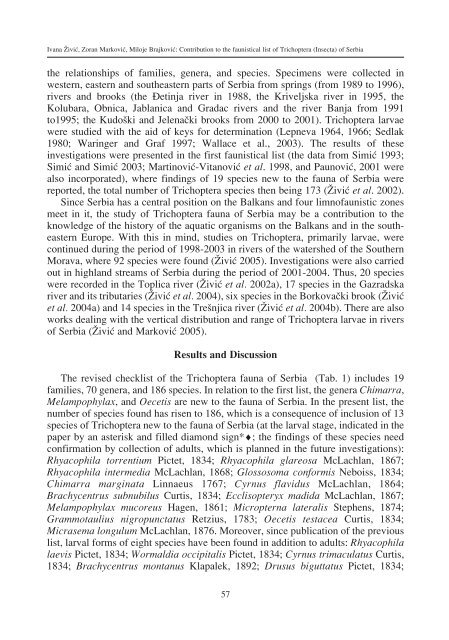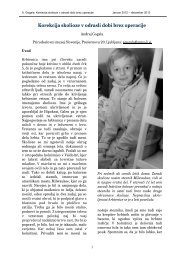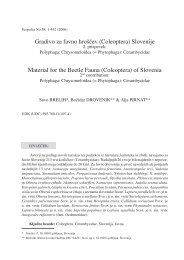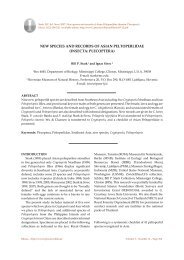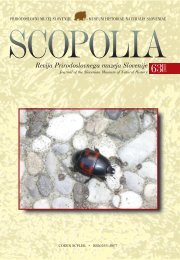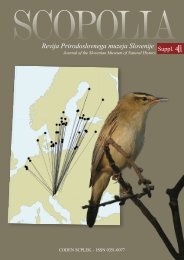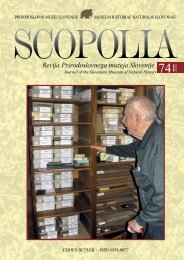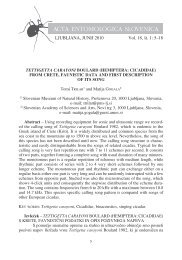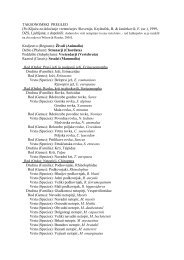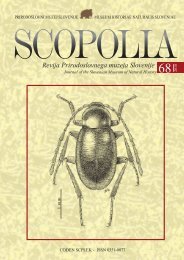Vsebina / Content (.pdf) - Prirodoslovni muzej Slovenije
Vsebina / Content (.pdf) - Prirodoslovni muzej Slovenije
Vsebina / Content (.pdf) - Prirodoslovni muzej Slovenije
- No tags were found...
You also want an ePaper? Increase the reach of your titles
YUMPU automatically turns print PDFs into web optimized ePapers that Google loves.
Ivana Æiviå, Zoran Markoviå, Miloje Brajkoviå: Contribution to the faunistical list of Trichoptera (Insecta) of Serbiathe relationships of families, genera, and species. Specimens were collected inwestern, eastern and southeastern parts of Serbia from springs (from 1989 to 1996),rivers and brooks (the fletinja river in 1988, the Kriveljska river in 1995, theKolubara, Obnica, Jablanica and Gradac rivers and the river Banja from 1991to1995; the Kudoøki and Jelenaœki brooks from 2000 to 2001). Trichoptera larvaewere studied with the aid of keys for determination (Lepneva 1964, 1966; Sedlak1980; Waringer and Graf 1997; Wallace et al., 2003). The results of theseinvestigations were presented in the first faunistical list (the data from Simiå 1993;Simiå and Simiå 2003; Martinoviå-Vitanoviå et al. 1998, and Paunoviå, 2001 werealso incorporated), where findings of 19 species new to the fauna of Serbia werereported, the total number of Trichoptera species then being 173 (Æiviå et al. 2002).Since Serbia has a central position on the Balkans and four limnofaunistic zonesmeet in it, the study of Trichoptera fauna of Serbia may be a contribution to theknowledge of the history of the aquatic organisms on the Balkans and in the southeasternEurope. With this in mind, studies on Trichoptera, primarily larvae, werecontinued during the period of 1998-2003 in rivers of the watershed of the SouthernMorava, where 92 species were found (Æiviå 2005). Investigations were also carriedout in highland streams of Serbia during the period of 2001-2004. Thus, 20 specieswere recorded in the Toplica river (Æiviå et al. 2002a), 17 species in the Gazradskariver and its tributaries (Æiviå et al. 2004), six species in the Borkovaœki brook (Æiviået al. 2004a) and 14 species in the Treønjica river (Æiviå et al. 2004b). There are alsoworks dealing with the vertical distribution and range of Trichoptera larvae in riversof Serbia (Æiviå and Markoviå 2005).Results and DiscussionThe revised checklist of the Trichoptera fauna of Serbia (Tab. 1) includes 19families, 70 genera, and 186 species. In relation to the first list, the genera Chimarra,Melampophylax, and Oecetis are new to the fauna of Serbia. In the present list, thenumber of species found has risen to 186, which is a consequence of inclusion of 13species of Trichoptera new to the fauna of Serbia (at the larval stage, indicated in thepaper by an asterisk and filled diamond sign*®; the findings of these species needconfirmation by collection of adults, which is planned in the future investigations):Rhyacophila torrentium Pictet, 1834; Rhyacophila glareosa McLachlan, 1867;Rhyacophila intermedia McLachlan, 1868; Glossosoma conformis Neboiss, 1834;Chimarra marginata Linnaeus 1767; Cyrnus flavidus McLachlan, 1864;Brachycentrus subnubilus Curtis, 1834; Ecclisopteryx madida McLachlan, 1867;Melampophylax mucoreus Hagen, 1861; Micropterna lateralis Stephens, 1874;Grammotaulius nigropunctatus Retzius, 1783; Oecetis testacea Curtis, 1834;Micrasema longulum McLachlan, 1876. Moreover, since publication of the previouslist, larval forms of eight species have been found in addition to adults: Rhyacophilalaevis Pictet, 1834; Wormaldia occipitalis Pictet, 1834; Cyrnus trimaculatus Curtis,1834; Brachycentrus montanus Klapalek, 1892; Drusus biguttatus Pictet, 1834;57


